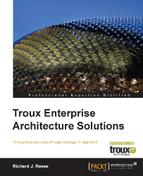The Architecture Repository is used to store different classes of architectural output at different levels of abstraction, as the ADM is followed. Major components of a generic EA repository are:
- The Architecture Meta-Model, which describes the overall architecture frameworks that have been tailored to the specific nuances of the organization.
- The Architecture Capabilities available through the EA repository. This defines what the repository is able to do and what it is intended to govern from an architectural perspective.
- The Architecture Landscape, which visualizes the SBBs and ABBs in use across the organization. It constitutes the list of live applications, their life cycles, and transition plans along with their supporting components.
- The Standards Information Base (SIB) for all IT standards of an organization. This may also include the ability to report on standards compliance and standards lifecycle information.
- The Reference Library, which includes guidelines, templates, notation standards, and design patterns for creating deliverables.
- The Governance Log, useful in managing change and measuring adherence to standards, guidelines, and design patterns.
A high-quality EA repository should also provide services such as import/export, online query, online and batch reporting, and meta-model extensibility. While the Troux Transformation Platform always supported the key features of an EA repository, in 2010, the company announced specific support for TOGAF. The figure below shows that a module for support of the TOGAF ADM is part of the systems architecture of the product.

This is the same high-level view of the Troux platform shown elsewhere in this book. However, the following will explain how Troux maps to the ADM.
Chapter 6, Architecture Models, identified that Troux supports Asset Domains and Concept Domains. These domains are manifested by the meta-models within the Troux Metaverse database. These domains and their meta-models were already covered in detail in the first chapters of the book. With Troux for TOGAF, however, a direct mapping is possible between the ADM phases and the domains. The following table shows these mappings:
|
Metaverse Domain |
TOGAF ADM Phase |
Comments |
|---|---|---|
|
Strategy |
Phase A—Architecture Vision |
Supports vision, strategies, goals, KPI's and alignment monitoring |
|
Location, Organization, Process, Resource, Application & Software |
Phase B—Business Architecture |
Defines organization units, resources, business processes, and capabilities |
|
Information, IT Architecture, Application and Software |
Phase C—Information System Architecture |
Specifies the application, information/data, and product architectures needed to provide SBBs. |
|
Services Portfolio, IT Architecture, Infrastructure & Hardware, IT Product, IT Service, |
Phase D—Technology Architecture |
Specifies the technology (ABBs) that support the architecture solutions (SBBs) |
|
Market, Financial, Knowledge & Skill, Product & Service, Transition, Timeline, Analysis |
Phase E—Opportunities & Solutions |
Supports future-state mapping, transition models, and transition visualizations |
|
Transition, Timeline, IT Product, IT Service, Analysis |
Phase F—Migration Planning |
Provides road-maps for transition to the future state architecture |
|
Infrastructure & Hardware, IT Product, IT Service, Market, Services Portfolio, Transition, Timeline |
Phase G—Implementation Governance |
Provides detailed information about IT standards (ABBs) and life cycle. Provides compliance reporting |
|
Transition, Timeline |
Phase H—Architecture Change Management |
Provides transition status reporting and compliance reporting |
While some of the ADM phases are supported directly through the Troux for TOGAF module, others are supported by the other modules within the Transformation Platform.
In particular, Troux Standards supports the formation of ABBs leading to their use in solutions as SBBs. Troux Standards supports the identification and governance of IT standards and Troux Architect provides the models of the current and future-states of the architectures. Troux Alignment provides deep-dive information into the Business Architecture via Capability Maps. Troux Optimization provides status on application transition and retirement plans. The combination of Troux Architect, Troux Alignment, Troux Optimization, Troux Standards, and the Troux for TOGAF module meets the specifications for an EA repository documented within TOGAF.
